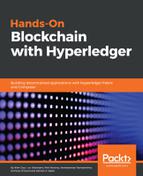Hyperledger Fabric follows a modular design, and the following are some of the possible components or modules that can be plugged in and implemented. Note that this list is not exhaustive:
- Membership services: This module is essentially a permissioning module and acts as a vehicle to establish a root of trust during network creation, but this is also instrumental in ensuring and managing the identity of members. Membership services are essentially a certificate authority as well as utilized elements of the public key infrastructure (PKI) for things such as key distribution, management, and establishing federated trust as the network grows. The membership services module provides a specialized digital certificate authority for issuing certificates to members of the blockchain network, and it leverages cryptographic functions provided by Hyperledger Fabric.
- Transactions: A transaction is a request to the blockchain to execute a function on the ledger. The function is implemented by a chaincode. Cryptography ensures integrity of transactions by linking the transaction to previous blocks and ensuring the transactional integrity, if protected, by linking the cryptogram or hash from previously linked blocks. Each channel in Hyperledger Fabric is its own blockchain.
- Smart contract or chaincode services: Chaincode is an application-level code stored on the ledger as a part of a transaction. Chaincode runs transactions that may modify the world state. Transaction logic is written as chaincode (in the Go or JavaScript languages), and executes in secure Docker containers. The transaction transforms data, scoped by chaincode on the channel from which it operates.
Here are the smart contract or chaincode elements enabled by chaincode services. Chaincode is installed on peers, which require access to the asset states to perform reads and writes. The chaincode is then instantiated on specific channels for specific peers. Ledgers within a channel can be shared across entire networks of peers or include only a specific set of participants. Peers are able to participate in multiple channels:
- Events: The process of validating peers and chaincodes can produce events (pre-defined events and custom events generated by chaincode) on the network that applications may listen for and take actions on. These events are consumed by event adapters, which may further deliver events using vehicles such as WebHooks or Kafka. Fabric-committing peers provide an event stream to publish events to registered listeners. As of v1.0, the only events that get published are Block events. A Block event gets published whenever the committing peer adds a validated block to the ledger:

- Consensus: Consensus is at the heart of any blockchain system. It also enables a trust system. In general, the consensus service enables digitally signed transactions to be proposed and validated by network members. In Hyperledger Fabric, the consensus is pluggable and tightly linked to the endorse-order-validation model that Hyperledger proposes. The ordering services in Hyperledger Fabric represent the consensus system. The ordering service batches multiple transactions into blocks and outputs a hash-chained sequence of blocks containing transactions.
- Ledger: Another component is a distributed encrypted ledger, including an append-only data store. This provides the ability to query and write data across distributed ledgers. There are two options:
- Level DB (default embedded KV DB) supports keyed queries, composite key queries, and key range queries
- Couch DB (external option) supports keyed queries, composite key queries, key range queries, plus full data rich queries
- Client SDK: A client SDK enables the creation of applications that deploy and invoke transactions atop a shared ledger. The Hyperledger Fabric Reference Architecture supports both Node.js and Java SDK. A software developer kit is like a programming kit or set of tools that provide developers with the environment of libraries to write and test chaincode applications. SDKs are critical in blockchain application development and will be discussed in detail in further chapters. Specific capabilities included in the SDK are the application client, chaincode, users, events, and crypto suite.
